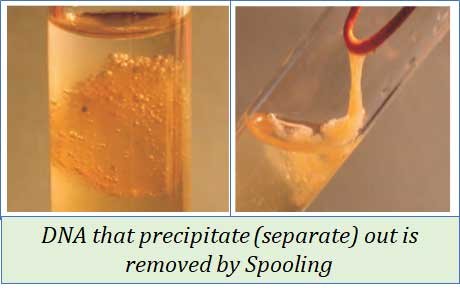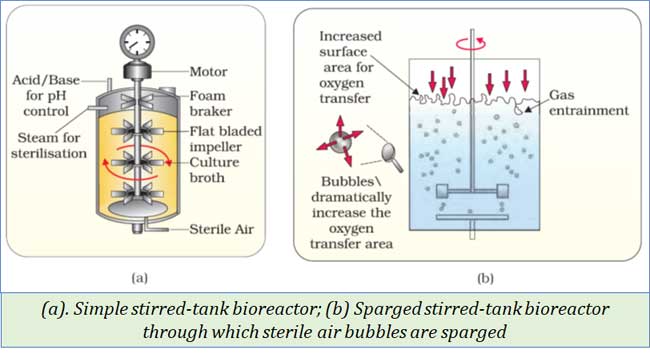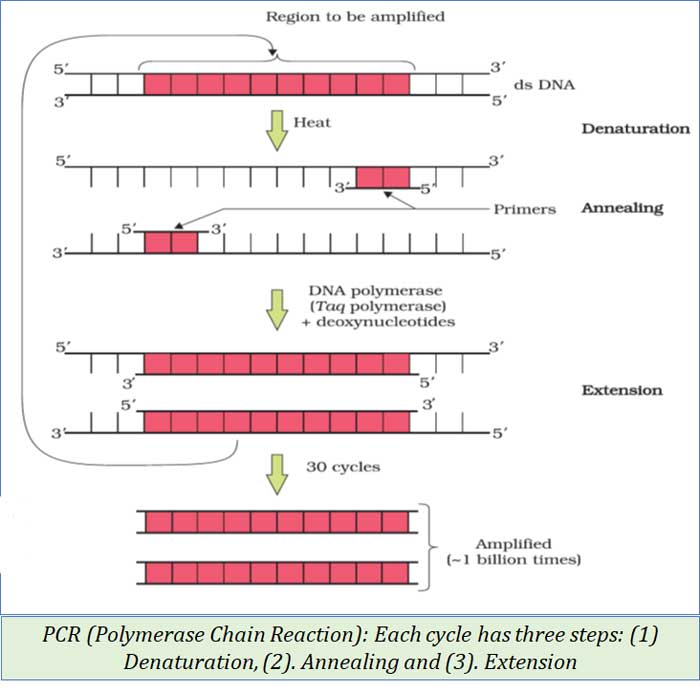Biotechnology Principles and Processes Class 12: This is the Part-2 of the notes of NCERT Class-12 Biotechnology Principles and Processes Chapter. This article discusses the Process or Steps in Recombinant DNA Technology and Fermentation Technology. This is the continuation of our Plus Two Botany Notes series. You can download the PDF for this notes from the Download Link given at the endo of the article.
Part-1 of NCERT Biotechnology Principles and Processes
PROCESS OF RECOMBINANT DNA TECHNOLOGY
What is Recombinant DNA Technology?
Ø Altering the genetic material outside an organism to obtain enhanced and desired characteristics in living organisms or as their products is called Recombinant DNA Technology or rDNA technology.
What is Recombinant DNA?
Ø DNA that has been formed artificially by combining constituents from different organisms.
7 Steps in Recombinant DNA Technology
Ø Recombinant DNA Technology consists of the following seven steps.
(1). Isolation of (DNA)
(2). Fragmentation of DNA by restriction endonucleases
(3). Isolation of a desired DNA fragment
(4). Ligation of the DNA fragment into a vector
(5). Transferring the recombinant DNA into the host
(6). Culturing the host cells in a medium at large scale
(7). Extraction of the desired product
(1). Isolation of the Genetic Material (DNA)
Ø DNA molecules are seen inside the cell
Ø DNA consists of proteins, RNA, enzymes etc.
Ø DNA must be in pure form without any other macromolecules such as proteins or carbohydrates.
Ø Pure DNA can be obtained by the following methods:
(a). Opening the cell and releasing the DNA using digestive enzymes
Ø Bacterial cells are treated with lysozyme enzyme to digest the cell. Lysozyme enzyme break the peptidoglycan cell wall of bacteria.
Ø Plant cell can be treated with cellulase to digest the cell wall. Cellulase enzyme digest the cellulosic cell wall of plants.
Ø Fungal cell can be treated with chitinase to digest the fungal cell wall. Chitinase enzyme digest the cell wall of fungi which is made of chitin.
(b). Removal of macromolecules
Ø RNA and proteins are the important macromolecules obtained during isolation of DNA. These two macromolecules should be removed for getting pure DNA.
$. RNA can be removed by treating with ribonuclease enzyme.
$. Proteins can be removed by treating with protease enzyme.
Ø After a number of treatments, DNA is purified
Ø Purified DNA is precipitated by treating with chilled ethanol
Ø Spooling is the process of removing separated DNA

(2). Fragmentation of DNA by restriction endonucleases
Ø This is the cutting of DNA at specific locations.
Ø Restriction enzymes are used to cut the purified DNA into fragments (see previous chapter for more details)
Ø Cutting of DNA is done only at specific points.
(3). Isolation of the desired DNA fragment
Ø DNA fragments are separated using Gel Electrophoresis.
Ø They are separated based on their size under the influence of electric field
Ø Negatively charged DNA molecules move towards the anode
Ø Then the desired DNA fragment is extracted and isolated from the gel piece
(4). Ligation of the isolated DNA fragment into the vector
Ø Both the plasmid/vector and the foreign DNA are cut with the same restriction enzyme
Ø DNA ligase enzyme joins the isolated DNA fragment with the sticky ends of the vector DNA
Ø Thus, recombinant DNA is formed
Amplification of gene of interest using PCR
Ø PCR: Polymerase Chain Reaction
Ø It is a technique used to make multiple copies of a specific DNA
Ø This is called amplification of gene.
Requirements for PCR
(a). DNA template
Ø The double stranded DNA to be amplified
(b). Two sets of primers
Ø A primer is a short DNA strand of about 10-18 nucleotides
Ø It serves as a starting point for DNA synthesis
Ø Primers are complementary to a region of template DNA
(c). DNA polymerase enzyme
Ø Gene amplification is carried out by DNA-Polymerase enzyme
Ø Commonly used polymerase in PCR is Taq polymerase
Ø It is thermostable DNA polymerase
Ø It remains active during high temperature at 720C
Ø It is isolated from a bacterium Thermus aquaticus
Steps in PCR: Three steps
(a). Denaturation
Ø The template DNA is heated to a high temperature to separate the two DNA strands
Ø Each single strand acts as a template for the synthesis of new DNA
(b). Primer Annealing
Ø Primers anneal to 3’ end of each single stranded DNA template
Ø It occurs at low temperature (400C-600C)
(c). Primer Extension
Ø Primers are extended by DNA polymerase enzyme
Ø It adds complementary nucleotides to the template provided in the reaction
(5). Insertion of recombinant DNA into the host cell/organism
Ø Host cells are made competent to take up the recombinant DNA.
Ø Selectable markers – tetR and ampR- are used to select recombinants
Ø Non-transformants will die in both tetracycline and ampicillin containing medium
Ø Transformant with recombinant DNA will grow in ampicillin containing medium, but not on tetracycline containing medium
Ø Transformant with non-recombinant DNA will grow on both tetracycline and ampicillin containing medium
(6). Culturing the host cells in a medium at large scale
Ø This is for obtaining enough quantity foreign gene product
Culturing the host cells
Ø The host cells are cultured in nutrient medium providing optimal conditions
Ø The DNA expresses to produce the desired product
(7). Extraction of the desired gene product
Ø Foreign gene products can be produced on small scale or large scale
Ø On small scale, the cells can be grown on cultures and the protein (gene product) is extracted and purified by different separation techniques
Ø On large scale, cells can be grown in Bioreactors
BIOREACTORS
Ø Bioreactors are vessels of large volumes in which raw materials are biologically converted into specific products using microbial, plant, animal or human cells
Ø Bioreactors are used to obtain foreign gene products in larger quantities
Ø These are provided with all the optimal conditions for attaining the desired product such as temperature, pH, substrate, salt, vitamins, oxygen etc.
Ø Foreign gene product is produced in larger biomass
Ø Different components of a bioreactor are:
(a). Agitator system
(b). Oxygen delivery system
(c). Foam control system
(d). Temperature control system
(e). pH control system
(f). Sampling ports to withdraw cultures periodically
Ø Bioreactors are of two types:
(1). Simple Stirred-Tank bioreactor
Ø Commonly used bioreactor
Ø It is cylindrical shaped with curved base
Ø This shape facilitates proper mixing of the contents
Ø It has a stirrer to mix the contents and make oxygen available throughout the bioreactor
(2). Sparged Stirred Tank Bioreactor
Ø It is also a stirred-tank bioreactor
Ø Air is bubbled at the bottom of the tank through a porous ring called sparger

Downstream Processing
Ø It is a series of processes involved in the separation and purification of the gene product
Ø After this step only, the product could be marketed as a finished product
Ø Downstream processing includes:
$. Separation and purification of gene product
$. Addition of suitable preservatives
$. Clinical trials (drugs)
$. Quality control testing
Review Questions Biotechnology Principles and Processes
(1). What is meant by rDNA technology?
(2). Define recombinant DNA.
(3). What are the seven steps of recombinant DNA technology?
(4). How DNA can be isolated from bacterial, plant and fungal cells?
(5). What is meant by spooling?
(6). What is the use of gel-electrophoresis in rDNA technology?
(7). What is ligation? How ligation can be done?
(8). What is PCR? What is significance in recombinant DNA technology?
(9). What are the requirements for performing PCR?
(10). What are the three steps of PCR?
(11). What are bioreactors? Mention the parts of a bioreactor.
(12). What is meant by downstream processing?
So far, we have completed the discussion of Part-2 of Plus Two Botany Biotechnology chapter – The Process of Biotechnology. In the next article we will discuss the Applications of Biotechnology. You can Download the PDF of this note from the link given below. Hope this post was helpful for your learning. We would like to hear it from you. Please COMMENT (below ↓)
<<< Back to PLUS TWO BOTANY NOTES Page
Download the PDF version of this Article
You might also like…
@. Plus Two Biology Previous Year Question Papers
@. Plus One Biology Previous Year Question Papers
@. Model Question Papers

